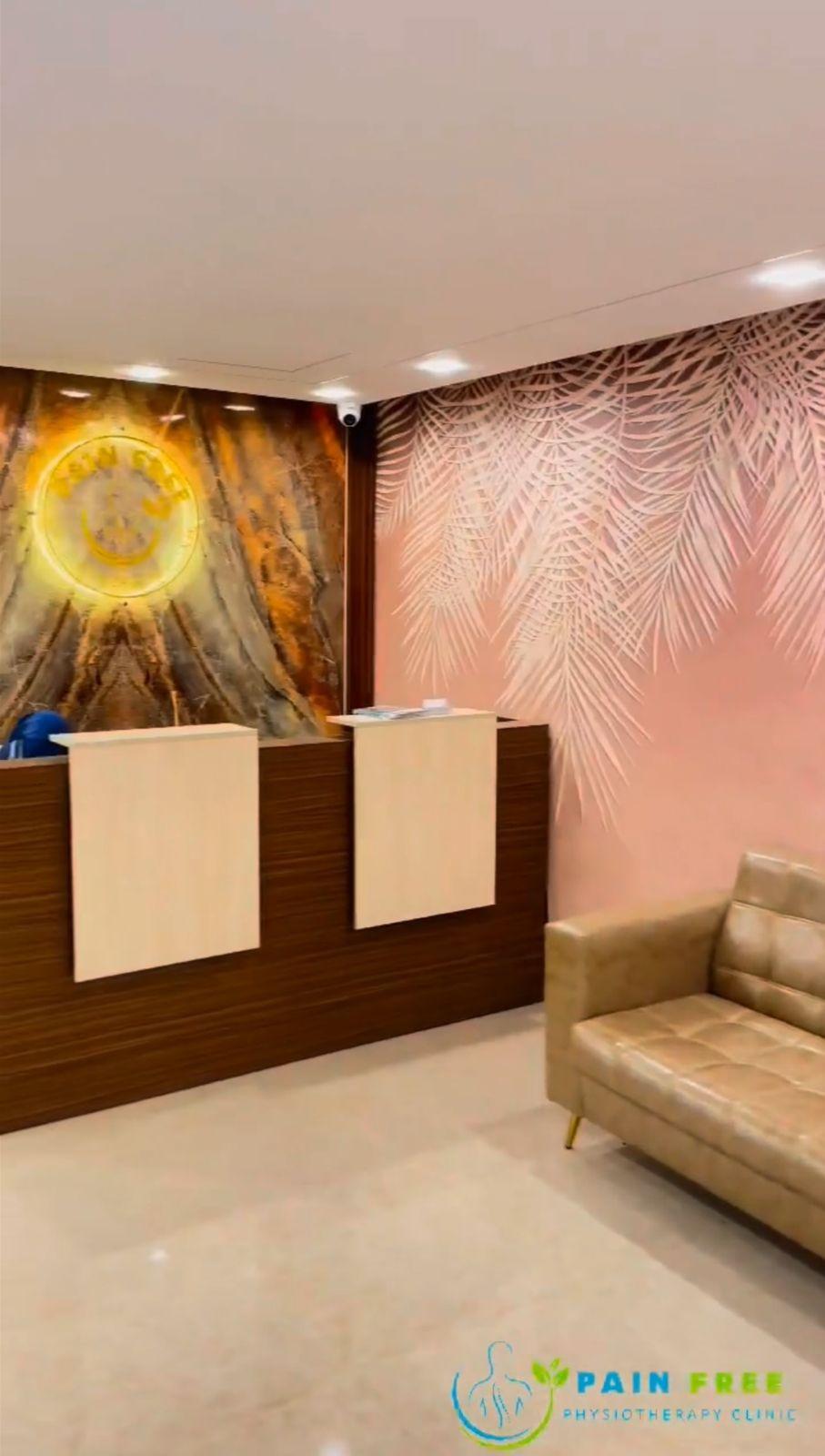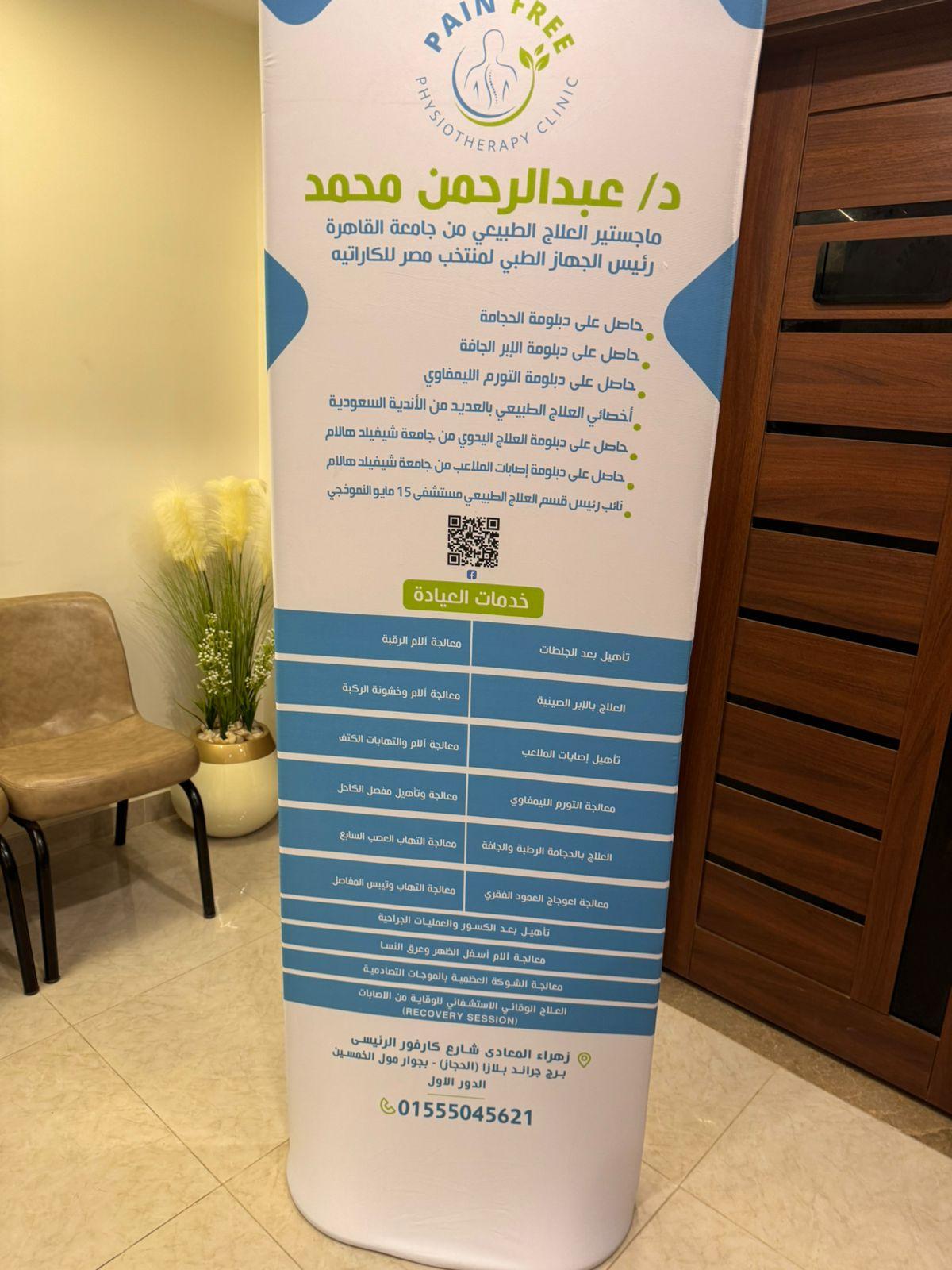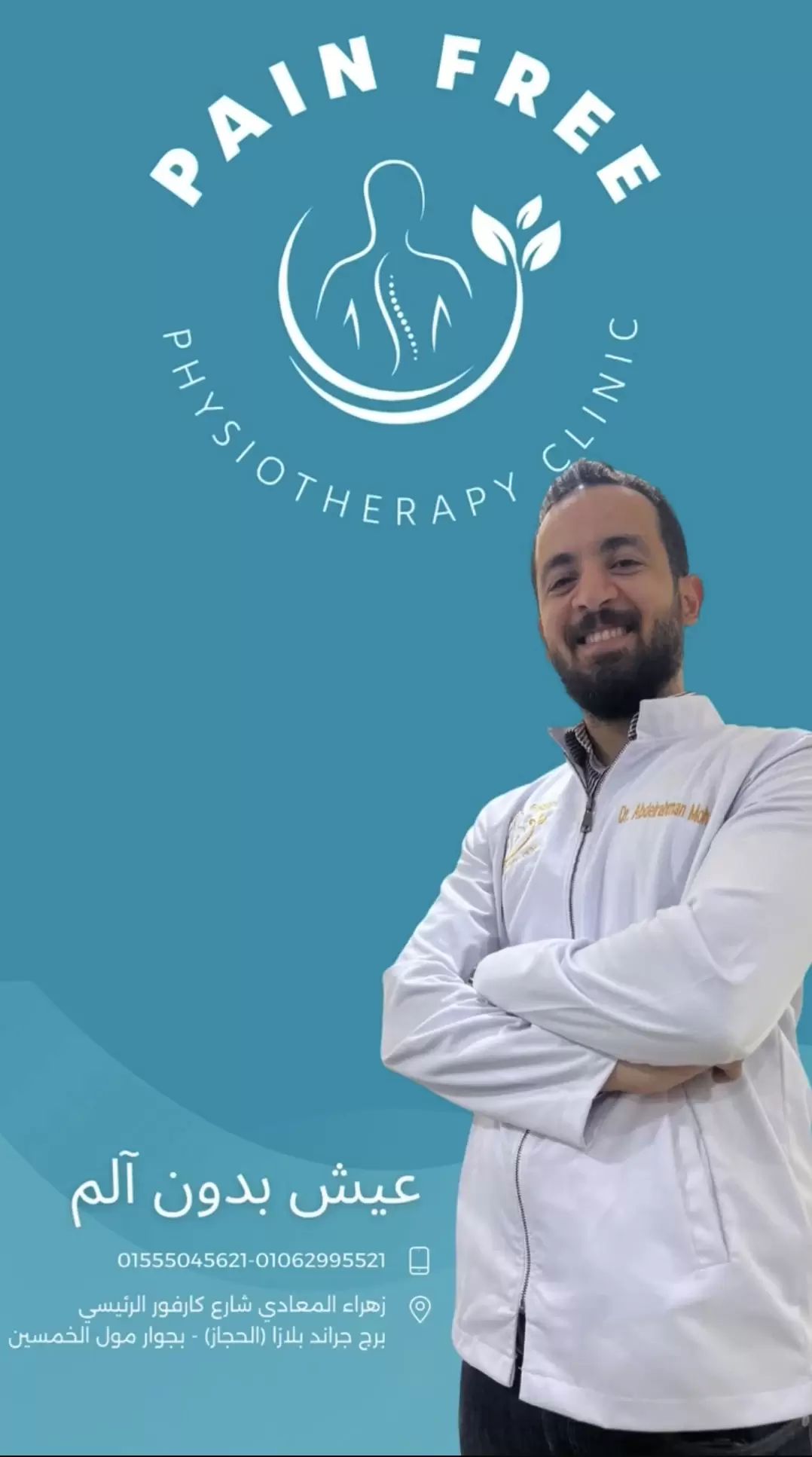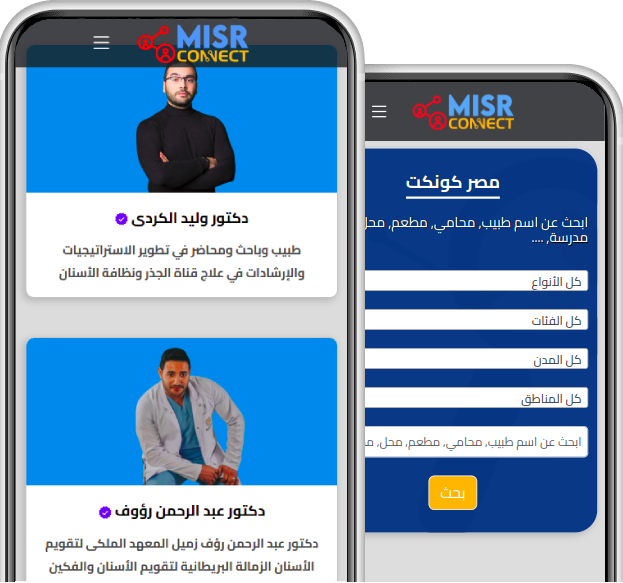Physical therapy is a non-medical treatment that relies on specialized techniques to improve movement, relieve pain, and enhance recovery for conditions affecting muscles, joints, and nerves.
Pain Free Clinic Dr Abdelrahman | Physiotherapy Center
Pain Free Clinic Dr Abdelrahman | Physiotherapy Center
- Phone: 01555045621
- Website:
- Opens at: 15:00
- Closes at: 22:00
Working Days
Sunday
Monday
Tuesday
Wednesday
Thursday
Saturday
FAQ
Shock wave therapy has been globally approved for several conditions related to pain, such as tennis elbow, elbow tendon pain, Achilles tendon pain, and back pain caused by muscle fiber inflammation or conditions that involve chronic pain, including mild degenerative disc disease or herniated discs due to surrounding muscular problems, and old tears.
It is also used for conditions like calcaneal spur, patellar inflammation ("kneecap"), and sometimes selectively in experimental cases for delayed bone healing and some cases of bone degeneration.
This treatment is an alternative to surgery in many cases, such as calcaneal spurs, and it can eliminate them completely, God willing, within just 6 sessions.
Its main advantage is that it provides a quick solution, thanks to God, with very good results, exceeding 90% in most cases. Additionally, it is non-surgical, so there is no cutting, anesthesia, or stitching. It is also safe for the elderly and does not pose a risk to the heart, making it a great option compared to other treatments.
Because rehabilitation after surgery speeds up the recovery rate, regardless of the type of surgery you had.
Rehabilitation after surgeries starts from the moment you leave the operation, and the sooner you start, the quicker you will improve and return to your life.
Quick rehabilitation will help you in:
- Improving movement, balance, and strength.
- Enhancing blood circulation and maintaining the overall strength of the heart muscle.
- Reducing pain and swelling.
- Preventing joint stiffness, which is a result of reduced joint movement after surgery.
- Better muscle formation and restoring muscle strength and flexibility.
- Reducing scar tissue formation.
- Reducing surgical complications.
- Restoring lost strength.
If you are an athlete, work in an office, have a physically demanding job, or suffer from scattered muscle pain, then recovery sessions are the best option for you! Take care of your muscle healing naturally through focused physical therapy techniques. This enhances the speed of your recovery and restores the flexibility of your spine. Discover many benefits of recovery sessions, which have numerous advantages for overall health, especially for the neuromuscular system, and help protect against injuries.
💥 Some of the key benefits include:
- Increased blood flow to the muscles, which improves muscle flexibility and strength.
- Reducing the risk of herniated discs, muscle tears, and joint stiffness.
- Enhancing endurance and effort, improving performance efficiency.
- Feeling relaxed and relieved from muscle tightness.
- Alleviating pain points and reducing their impact on muscles.
- Improving recovery from minor injuries and preventing their accumulation."
Lymphatic drainage is the ideal solution to stimulate your lymphatic system 💧. It enhances blood circulation 🩸, helps eliminate toxins and excess waste from the body 🚿, and reduces bloating and swelling.
It is the best way to get rid of trapped fluids through the lymphatic system by applying pressure to direct these fluids toward the lymph nodes, making it easier for the body to expel them.
The lymphatic drainage device for swelling in the legs and lower limbs has many benefits, including:
- Helps redistribute blood circulation properly in the lower limbs.
- Can be used for all age groups.
- Recovery sessions for muscle fatigue for athletes.
- Swelling after surgeries.
- Post-liposuction recovery.
- After vascular surgeries.
- Varicose veins and lymphatic filariasis.
- Swelling after injuries.
What are the benefits of lymphatic drainage sessions?
• Elimination of excess fluids. • Increased energy. • Improved immune system. • Provides relief from chronic pain. • Reduces recovery time after surgery. • Reduces swelling. • Softens scar tissues and other tissues.
Physical therapy is usually not painful if performed correctly, but some treatments may cause temporary discomfort, especially if they involve muscle or joint rehabilitation.
The duration of a session at physical therapy centers typically ranges from 30 to 60 minutes, depending on the patient's condition and the type of treatment required. The length of the session is tailored to ensure effective therapy while addressing the specific needs of each individual.
Workplace injuries that are treated in physical therapy centers typically involve the musculoskeletal system, such as muscles, joints, and tendons. Some of the common injuries include:
-
Muscle strains and tears:
- Muscle tears or strains caused by lifting heavy weights or repetitive movements.
- Muscle pain resulting from continuous pressure or strain.
-
Sprains of tendons or ligaments:
- Injuries caused by twisting or overstretching tendons or ligaments, especially in the ankle, knee, or wrist.
-
Fractures:
- Fractures resulting from accidents at work, requiring rehabilitation after healing to strengthen muscles and joints.
-
Spinal injuries and back pain:
- Lower back or neck pain resulting from lifting heavy loads or sitting for long periods in incorrect postures.
-
Tendonitis:
- Conditions like tendonitis in the shoulder or knee (e.g., rotator cuff tendonitis) caused by repetitive movements at work.
-
Carpal Tunnel Syndrome:
- A common condition among workers who perform repetitive hand or wrist movements, causing pressure on the median nerve in the wrist.
-
Stress from computer work:
- Neck, shoulder, and wrist pain, and tendonitis caused by prolonged computer use.
-
Injuries from poor posture:
- Back or neck pain caused by improper sitting or repetitive movements.
Physical therapy for these injuries includes various techniques such as therapeutic exercises, massage, heat or cold therapy, electrical stimulation, and flexibility and strengthening exercises to rehabilitate the patient and improve movement while reducing pain.
It depends on your condition. Some people feel improvement after the first session, while others may need 6-10 sessions or more.
It shouldn't be painful, but you might feel some tightness or mild soreness in the muscles, which is normal with the exercises.
Spinal curvature treatment in physical therapy centers focuses on strengthening the muscles surrounding the spine and improving the overall flexibility of the body to relieve symptoms and improve posture. Treatments provided in physical therapy centers include:
-
Therapeutic Exercises:
- Exercises aim to strengthen the back and abdominal muscles to provide better support for the spine.
- Exercises to improve balance and flexibility, which help improve posture and reduce curvature.
- Exercises to restore proper spinal alignment and reduce stress on the vertebrae.
-
Manual Techniques (Manipulation):
- Physical therapists use manual techniques to relieve muscle tension and improve spinal movement.
- These techniques can help alleviate pain and improve flexibility.
-
Massage Therapy:
- Massage helps relax tense muscles and relieve pain caused by spinal curvature.
- It also improves circulation and promotes relaxation.
-
Use of Supportive Devices:
- In some cases, physical therapists may recommend the use of supportive devices (braces) to support the spine during treatment or to prevent further progression of the condition.
-
Breathing Exercises and Relaxation Techniques:
- Deep breathing and relaxation techniques help reduce body tension and improve overall comfort.
-
Posture Guidance:
- Physical therapists guide patients on how to sit, stand, and walk correctly to avoid unnecessary pressure on the spine.
- They also teach patients how to adjust their environment, such as modifying desk height or using supportive chairs.
The main goal of physical therapy is to reduce pain, improve movement, and enhance the patient's quality of life, while working to reduce or prevent the progression of the curvature if it is in its early stages.
Electrical physical therapy sessions, such as those using electrical currents (e.g., interferential currents or nerve stimulation), are generally safe when performed under the supervision of a qualified physical therapist. However, they may have some risks or side effects in certain cases, such as:
- Skin irritation: Redness or irritation may occur at the site where the electrical current is applied.
- Pain or tingling sensation: Some patients may experience pain or a tingling feeling during the treatment.
- Interaction with medical devices: Electrical therapy should be avoided if the patient has implanted medical devices, such as a pacemaker.
- Pregnancy or skin conditions: Electrical therapy is usually not recommended for pregnant women or individuals with certain skin conditions.
It's important to consult with a physical therapist before starting treatment to ensure it is safe and suitable for your specific health condition.
Electric therapy sessions, or electrical stimulation therapy, are used to treat a variety of health conditions. The main goal of this therapy is to use electrical currents to stimulate nerves or muscles in a painless manner to improve health. Some of the conditions that can be treated with electrical therapy sessions include:
- Muscle and bone pain: Used to relieve back pain, neck pain, joint pain, and muscle pain.
- Soft tissue injuries: Such as tendon tears or muscle strains.
- Muscle spasms: Electrical stimulation can help reduce muscle spasms.
- Nerve stimulation: Helps improve blood circulation and reduce nerve pain, such as pain caused by sciatica.
- Muscle rehabilitation: Used after surgeries or accidents to rehabilitate muscles.
- Post-surgery healing stimulation: Helps speed up the healing process and reduce swelling or pain after surgeries.
This technique is generally safe when used under the supervision of medical professionals, but it should not be used in some cases, such as for people with pacemakers or pregnant women in certain situations.
Physical therapy focuses on pain relief and improving movement, while rehabilitation focuses on helping a person return to their normal life after injuries or surgeries.
It should have certified doctors, modern equipment, and assess your condition individually with proper attention. Ask people who have dealt with them before.
What's most important to us is not just financial profit, but the primary goal is the patient's benefit and achieving the best possible result with the least pain and in the shortest time. We want the patient to be satisfied with their condition and become an ambassador for us among their family and friends.
The consultation fee is only 200 EGP.
The prices for sessions range between 300 to 600 EGP, depending on each case and the equipment used in the session.



